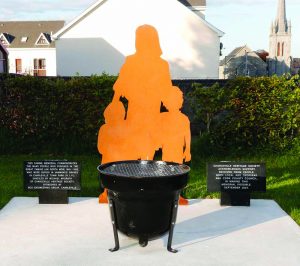
The official opening of the famine memorial in Charleville Town will take place on the evening of Friday the 16th May in the town park at 7.30pm, the day prior to the National Famine Day being commemorated in the country.
The memorial was erected in the town park to remember the many people who perished in the then fever hospital located adjacent to the park at Smith’s Lane Charleville between 1845 and 1852. Anecdotally, and in local folklore, it is noted that hundreds of people who died in the hospital during those years were taken to the field across from the hospital in bottomless coffins, and buried in mass graves.
Bones unearthed when the park was being developed in recent years ago, and sent to the Cork County coroner for analysis. However, there has been no official confirmation, as yet as to whether they come from that period. But tradition insists that that this is the case, and the memorial was erected in this location on that basis.
Charleville was then subject to the Kilmallock Poor Law Union because of its proximity to the Limerick border, instead of the Mallow Union then around twenty miles away. Any records that are available may be held in the Limerick County Archives, and may account for the long delay in getting confirmation on the bones issue. The fever hospital closed in 1854 when the famine was deemed to be ended, and the building was handed over to the nuns of the Mercy Order to be run as an industrial school, which it was for a number of years, before being used as St. Joseph’s Infants School.
Astonishingly, the local Convent of Mercy has no record of the devastating famine conditions in the town during those years in their annals, except to mention that they were tending to the poor of the town. Neither is there any mention of the forced evictions of four hundred people in the slum clearance programme initiated by the then Earl of Orrery, from the Glen area, along the edge of what is now Holy Cross Place, at the southern entrance to Charleville town.
Some four hundred people were evicted from the wretched hovels that they called home by the agents of the Earl assisted by the local police force. It is recorded in newspaper reports of the day that they sought shelter among the grave stones of Holy Cross Cemetery, which was on the opposite side of the roadway, when they were evicted.
The old fever hospital building is still in use today, and is known as the Mannix Block at St. Mary’s Secondary School for girls.





